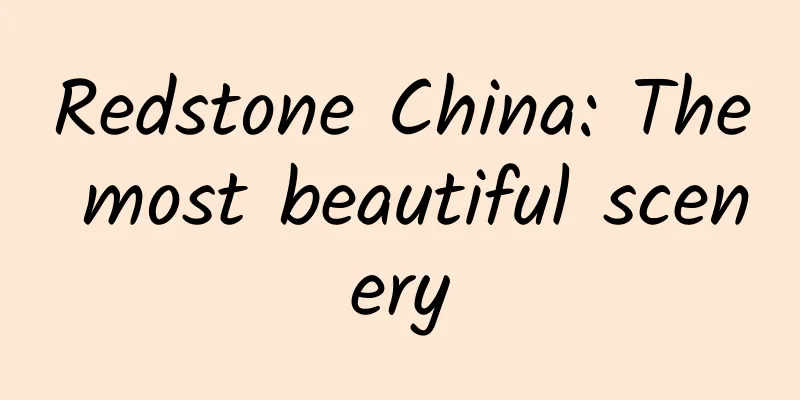Redstone China: The most beautiful scenery

|
Color is a simple and straightforward observation in petrology. Geologists often use color to describe rocks or distinguish mineral compositions, and the surface color of rocks often becomes an interpretation mark in remote sensing technology. Scientists have found that iron-containing minerals in sedimentary rocks can make rocks appear specific colors, such as hematite, which makes them red, and most trivalent iron compounds, which make rocks orange-red to yellow. Divalent iron compounds such as chlorite and iron sulfide can make rocks appear dark colors, such as green, gray or even black. They also found that the color of the rock is also related to the formation environment. Sediments in the alternation of hot and dry and wet seasons are often intermittently exposed to water, making it more likely to form red rock layers. ▲The red rock formations on the northern edge of the Junggar Basin in Xinjiang are washed by seasonal water. Image/Mapbox satellite hybrid image The red beds widely distributed in my country's basins and margins are affected by mineral elements and sedimentary environment. The term red beds was first proposed by Li Siguang, referring to continental clastic rocks since the Mesozoic era, which are mainly red in color. my country's red beds are mainly distributed in the southwest, south, southeast and northwest regions. The four major basins, the Shaanxi-Gansu-Ningxia basin, and the central and southern parts of the Yunnan Plateau all have complete red beds. ▲Colorful hills in Nantai, Zhangye, photo by Li Zhongdong In addition, some carbonate rocks also appear red, forming a more unique red carbonate landscape. Fissures and joints, flowing water and wind and sand have made these red rocks form an extremely enchanting landscape over the years. They are a feast of colors, a magical "city", and the reddest China... ▲The red rock formations in Wuerhe after the rain appear very bright. Photo by Gu Jianjun 01 Danxia landform The word "Danxia" comes from Cao Pi's "Poems in Furong Pond" "Danxia sandwiches the bright moon, and Huaxing emerges from the clouds". In 1928, Chinese geologist Feng Jinglan first proposed the Danxia layer in Danxia Mountain in Guangdong. After a hundred years of continuous and in-depth research by scholars such as Chen Guoda, Zeng Zhaoxuan, Huang Jin, and Peng Hua, Danxia landform finally became a landform type named by Chinese geologists. Cracks and joints, flowing water and wind and sand have made these red rocks form an extremely enchanting landscape over the years. They are a feast of colors, a fantasy "city", and the reddest China... my country's Danxia landforms are widely distributed in tropical and subtropical humid areas, temperate humid-semi-humid areas, semi-arid-arid areas and the Qinghai-Tibet Plateau high-cold areas. They are mainly distributed in South China, Northwest China and Southwest China. In these three regions with their own natural geographical environments, there are obvious differences in morphological characteristics, material structure, formation conditions and development process, and the Danxia landforms formed are also varied and unique. ▲Danxia Mountain in Shaoguan, Guangdong, with red Danxia peaks and hills. Photo by Yang Jian Danxia in the temperate area of South China The Danxia distribution area in South China has a subtropical and tropical humid climate. External forces such as water erosion, collapse, weathering, and dissolution play an important role in shaping the Danxia landform. Danxia Mountain in Guangdong is a representative of the Danxia landform in South China. The climate in this area is warm and humid, and the speed of tectonic uplift is slower than that in the northwest. Strong chemical weathering and water erosion have become the main external forces shaping the Danxia landform. Danxia landform landscapes such as red cliffs and red cliffs and a thin line of sky have developed, and are characterized by red mountains and clear waters. In addition, Hunan's Langshan, Jiangxi's Longhushan, Zhejiang's Jianglangshan, and Fujian's Taining are all typical representatives of this type of Danxia. ▲Danxia Mountain in Shaoguan, Guangdong. Photo by Yang Jian Danxia in Southwest China The Danxia landform in the southwest is mainly characterized by long red cliffs, circular cliffs, and high waterfalls on cliffs, hidden in the jungles and gullies. We named this kind of Danxia with "cliffs but no peaks" and huge circular red cliffs as Huanya Danxia to distinguish it from the Danxia landform in the southeast and the Danxia landform in the arid northwest. According to research, this unique Danxia only appears at the junction of Sichuan, Guizhou and Chongqing provinces on the southern edge of the Sichuan Basin. It is distributed in Xuyong and Mabian in Sichuan, Chishui in Guizhou and Jiangjin in Chongqing, and Chishui is the distribution center and the most typical area. ▲Danxia cliffs around Pingshan in the Sichuan Basin. Photo by Yang Jian Danxia in the arid region of Northwest China After seeing the Danxia covered by lush green vegetation, when the Danxia in the northwest arid area of Zhangye appeared before my eyes, it almost overturned all my previous understanding of Danxia. The climate here is dry and the precipitation is scarce, which has formed Danxia cliffs and red-layer dry valleys with relatively small height differences. The development of a "window lattice palace structure" is also a notable feature of this type of Danxia. In addition to Gansu, Danxia in the arid region of Northwest China is also widely distributed in Qinghai, Xinjiang and other places. ▲Zhangye Binggou Danxia. Photo by Li Zhongdong ▲Zhangye Binggou Danxia, photo by Yang Jian 02 Yadan landform "Yadang" means "small hill with steep walls" in Uyghur. This is consistent with the morphological characteristics of the Yadan landform. In the early 20th century, Sven Hedin and Stein discovered this special landform in Lop Nur and used the word "Yadang" to describe it. Since then, "Yadang" has become a universal term for this landform around the world. Yardang landform is generally distributed in the hinterland or edge of the basin. Its material composition is sandstone, conglomerate and mudstone. These rocks are not well-cemented. Under the action of seasonal rainstorms and directional wind erosion, they form a series of landscape combinations such as ridges, mounds, earth pillars (mounds), wind erosion depressions, etc. that are parallel to the prevailing wind direction and arranged alternately with each other. It is a wind erosion landform, unique to the arid and windy northwest region, especially in Xinjiang. ▲Yardang landform in Wubao, Hami, Xinjiang. Photo by Li Zhongdong 03 Huoyan Mountain Landform There is also a widespread Huoyan Mountain landscape in the northwest. They are different from both the Yadan landform and the Danxia landform in the arid areas of the northwest. They are also a unique landform type in the northwest, with the Huoyan Mountain in Turpan as a typical example. ▲Turpan Huoyan Mountain. Photo/Rightsea, Tuchong Creative 04 Colored Hills The colorful hills develop in arid and semi-arid areas. They are shallow hills formed by Mesozoic colorful conglomerate, mudstone and siltstone. Under the erosion of seasonal rainstorms and strong winds, a landscape combination with red as the main color and rock layers of various colors interlaced has been formed. The color changes of the hills are controlled by the environment when the rock strata are deposited. In a dry hot oxidizing environment, the abundant iron oxide makes the rocks red, while in a reducing environment, the sediments are grayish white. Colorful hilly landforms are mainly developed in the arid northwest region, especially in Gansu and Xinjiang. ▲ Wucai Beach. Photo/Tianya Wanderer (TuChong Creative) ▲Colorful hills in Zhangye. Photo by Li Zhongdong 05 Red Canyon Millions of years of sedimentation have formed colorful rocks. Tectonic movements have caused the strata to tilt and rise. The water has cut through the mountains over the years, forming deep canyons. Entering the canyon is like entering the center of the earth. We are fortunate to see the strange landscape in the red strata. Famous red strata canyons include Kuche Canyon and Anjihai Canyon. ▲Kuqa Canyon. Image/TuChong Creative 06 Red carbonate rock landform At present, there are 28 countries or regions in the world where red beds have been found, but most of them are red sandstone conglomerate strata. From the perspective of global carbonate rock depositional environment and outcrop color, the main body is still gray-black and gray-white, and red carbonate rocks are rare, only appearing in a few platform shoal phase depositional areas such as the Yangtze Platform and Indochina Block in the Paleozoic. The red carbonate rocks in the world are only exposed in a very small area in Hunan, Chongqing, Sichuan, Guizhou, China and Satun, Thailand. The red carbonate stone forest in western Hunan has an exposed area of more than 84 square kilometers, which is the largest, most concentrated and most peculiar red stone forest landscape discovered in the world so far. ▲Red Stone Forest in western Hunan. Image/TuChong Creative 07 Red Rock Beach Red Stone Beach is a unique landscape, named after the red stones distributed in the river valley and river beach. It is found in large numbers in the eastern part of Hengduan Mountain. Red Stone Beach is mostly formed near snow-capped mountains and glaciers, usually in the riverbed where glacier meltwater gathers. The distribution altitude is generally between 2000-4000 meters. It is more likely to form in the U-shaped trough valley formed by glaciers and the debris flow accumulation area in the glacier area. The academic consensus on the red substance on the stone is that it is a living organism. The results of Professor Liu Guoxiang's research show that this is a new algae species, named Yoli orange algae. Under a microscope, this algae appears carpet-like, with short branched filaments, only 30 to 40 cells at most, and 2 to 3 millimeters long. They like to grow below 20 degrees Celsius and only grow on rocks. They are pioneer plants on rocks. ▲Red Stone Beach in Yajiagang, Kangding. Photo by Li Zhongyi -END- By Li Zhongdong Photo by Yang Jian, Li Zhongyi, TuChong Creative Source/Xiake Geography WeChat Official Account |
Recommend
Affected by the epidemic, domestic smartphone shipments in Q1 may drop by 30%
The ongoing outbreak of the novel coronavirus is ...
Gout equals "pain madness"? You must pay attention to these foods!
Our dad’s review, there is a Mr. Guo who does not...
Congratulations! Zhai Zhigang, Wang Yaping, and Ye Guangfu were awarded the Space Merit Medal
CPC Central Committee State Council Central Milit...
Epidemic + college entrance examination, how should we eat three meals a day?
Beijing will host the college entrance examinatio...
When information flow copywriting has been overused, how can you stand out and make users’ eyes light up?
Before we get into the topic, let’s look at a cas...
Japanese drama "Liar Game" full two seasons + movie version HD Japanese plug-in Chinese subtitles
Chinese name: Fraud game/Scam game Foreign name: ...
International Bird Day丨Come and learn about “birds”?
Since ancient times Beasts galloping in the fores...
This thing is not only not afraid of fire, it can also help people put out fires!
Plants occupy a very important position in human ...
The second issue of the Aiti Tribe live broadcast class: How to make good use of HTML5 in mobile Internet products?
[51CTO.com original article] 51CTO and APICloud h...
WeChat is cracking down on third-party links! All illegal diversions will be blocked
[[357215]] As a "cosmic center", WeChat...
Zhihu Operation: How to receive 10,000 yuan in advertising fees for one answer on Zhihu
On Zhihu, I earned 10,000 yuan in advertising fee...
Are you prone to allergies in spring? Preventing eczema is the key
As the temperature gradually rises Many friends c...
What to do if your phone is running low on memory? Learn these tips to restore your phone to a smooth state
[[435147]] The mobile phone memory we often talk ...
The first phase of 5G standards released, Chinese manufacturers accounted for 30% of the standards
The plenary meeting of the international standard...
How to operate Weibo? Sharing of Weibo operation ideas
Recently, many people have asked me how to operat...









